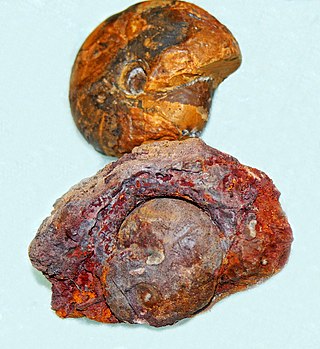Beyrichoceras is a genus belonging to the goniatitid family Muensteroceratidae, a group of ammonoids, extinct shelled cephalopods related to belemnites and recent coleoids and more distantly to the nautiloids

Beyrichoceras is a genus belonging to the goniatitid family Maxigoniatitidae that lived during the Mississippian Period

Goniatitina is one of two suborders included in the order Goniatitida; extinct Paleozoic ammonoid cephalopods only distantly related to the Nautiloidea.
Adrianitoidea is one of seventeen superfamilies currently included in the Goniatitina, but only one of six there included in the Treatise, 1957. Shells are subdiscoidal to globose with variable umbilici and sutures with 10 to 30 lobes, which tend to be subequal.
Cheiloceratidae is a family of ammonoid cephalopods included in the goniatitid suborder Tornoceratina in which the suture has 4 to 12 lobes, the ventral one undivided and those in the lateral areas originating as subdivisions of internal and external lateral saddles.
Pseudohaloritoidea, formerly Pseudohaloritaceae, is one of four superfamilies of the goniatitid suborderTornoceratatina. Although attributed the Ruzhencev, 1957 T.J Frest et al. included the Maximitidae and Pseudohaloritidae in the Cheilocerataceae in their May 1981 paper.
Pseudohaloritidae is the larger of two families that form the goniatitid superfamily Pseudohaloritoidea, the other being the monogenerc Maximitidae. They are part of the vast array of shelled cephalopods known as ammonoids that are more closely related to squids, belemnites, octopuses, and cuttlefish, than to the superficially similar Nautilus.
Tornoceratoidea, also known as Tornocerataceae, is a superfamily of goniatitid ammonoids included in the suborder Tornoceratina. Tornoceratoidea, or Tornocerataceae, is essentially the Cheilocerataceae of Miller, Furnish, and Schindewolf (1957) in the Treatise Part L, revised to accommodate new taxa and new perspectives on the phylogeny.
Tornoceratidae is a family of goniatitid ammonoids from the middle and upper Devonian. The family is included in the suborder Tornoceratina and the superfamily Tornoceratoidea.

Goniatitoidea, formerly Goniatitaceae in older publications, is a superfamily of late Paleozoic ammonoid cephalopods included in the Goniatitida. They are characterized by thinly discoidal to globular shells with variable umbilici and sculpture. The ventral lobe, located along the outer margin, is prominently bifurcated ; the lateral lobe undivided.

Neoicoceratoidea, formerly called Neoicocerataceae, is one of seventeen superfamilies of the Goniatitina suborder. Neoicoceratoidea comprises forms previously included in the Neoioceratidae and Metalegoceratidae, previously included in the Goniatitacae. These, along with new families defined for certain genera, including one from the Schistoceratidae, have been recombined as the Neoicocerataceae.
Adrianitidae is a family in the Adrianitaceae, a superfamily of ammonites in the cephalopod order, Goniatitida, known from the Middle Pennsylvanian to the Middle Permian.
Thalassoceratidae a family of late Paleozoic ammonites included in the goniatitid superfamily Thalassoceratoidea along with the Bisatoceratidae. Some eight genera are included, although the specific number and exactly which depends on the particular classification.

Medlicottiidae is a family of ammonoid cephalopods belonging to the Prolecanitida, known from the Upper Carboniferous (Pennsylvanian) to the Early Triassic.

Clyclolobus is a smooth, essentially involute subdiscoidal goniatitid ammonoid that has sutures with a bifurcate ventral lobe, flared outwardly at the end, in which the halves may be secondarily trifurcated, ending in sharp, narrow projections. Lateral sutural elements follow an acuate line that swings first to the front, then sharply to the rear before becoming hidden by the next whorl. Saddles are narrow, cumulous in appearance with short, irregular, rounded sub-endings. Ventro-lateal lobes are trifurcate with pointed, thorn-like projections.

Clymeniida is an order of ammonoid cephalopods from the Upper Devonian characterized by having an unusual dorsal siphuncle. They measured about 4 cm (1.6 in) in diameter and are most common in Europe, North Africa, and South China but are known from North America and Australia as well.
The Karagondoceratidae is a small family of tornoceratin Goniatitida from the Lower Carboniferous which typifies the Karagandoceratoidea, in which it is included.
Pachylyroceras is a large, generally subglobular, Upper Mississippian gonitite and included in the cephalopod subclass Ammonoidea.
Lyrogoniatitites is a neoglyphioceratoidean ammonite, in the order Goniatitida, related to genera like Alaoceras, Cravenoceras, Dumbarigloria and Pachylyroceras.
Cravevoceras is an Upper Paleozoic ammonite in the goniatite family Cravenoceratidae, probably derived from Pachylyroceras and contemporary with other cravenoceratid genera like Caenolyroceras, Tympanoceras and later Alaoceras and Lyrogoniatites. It is also a member of the Neoglyphioceratoidea.





